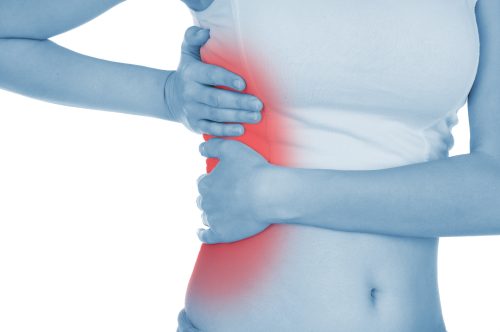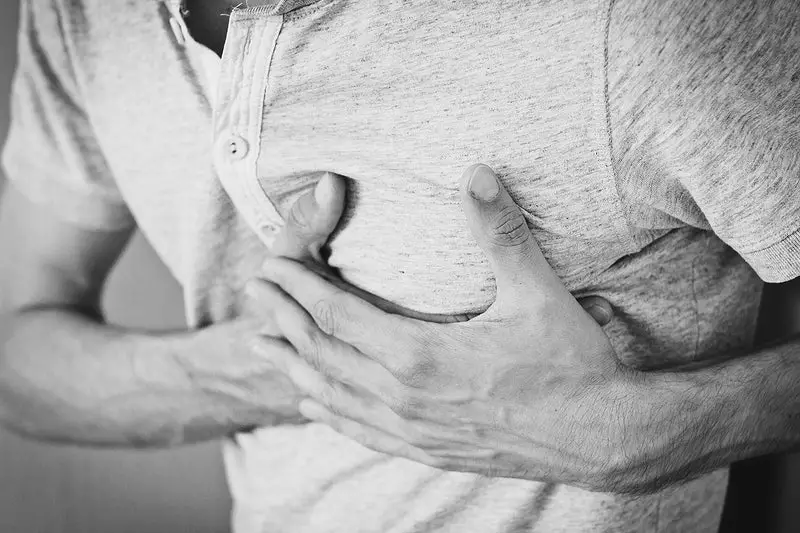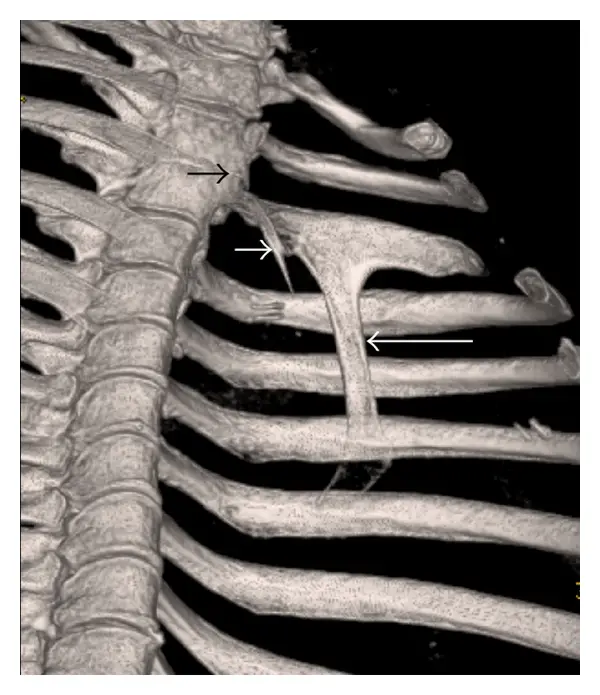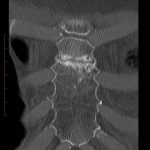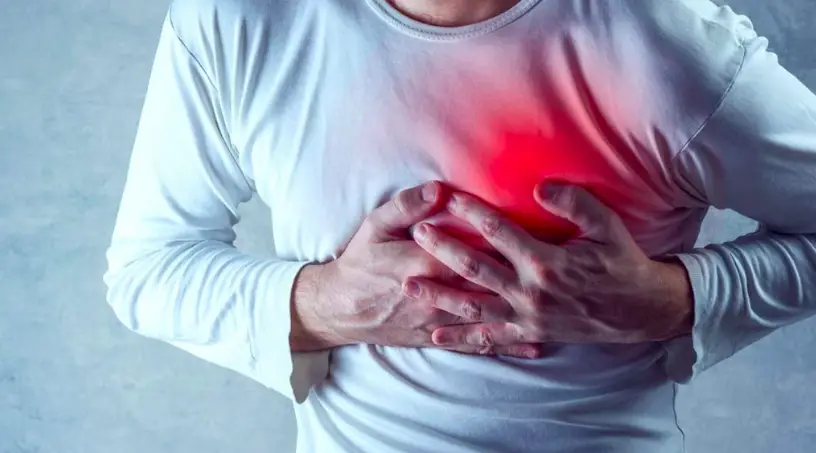A cracked rib corresponds to a crack in the ribs, one of the main elements of the rib cage. It causes a sharp pain and causes damagerespiratory difficulties. Sometimes it can get complicated in one respiratory infection.
A cracked rib appears following a trauma to the chest. But contrary to popular belief, there is no not just violent shocks which provoke it: even a minor trauma as a simple cough or sneeze can cause a cracked side especially in people at risk.
To find out more, read our article. You will see among other things the definition, causes and predisposed peoples to a cracked rib. You will also know the behaviour to have. At the end of the article, we we will answer recurring questions on the cracked coast.
The 5 essential points
- A cracked rib results in intercostal neuralgia.
- Athletes, the elderly and pregnant women are predisposed to a cracked rib.
- A cracked rib is confirmed by an x-ray.
- Wearing a chest belt and cryoneurolysis are among the therapeutic methods for a cracked rib.
- It takes at least several weeks for a cracked rib to fully recover.
What is a cracked rib?
Anatomical reminder of a rib
Etymologically, the word “coast” comes from the Latin “costae” which means " guardian ". The ribs are so named because they are “the guardians” organs of the chest. In fact, the ribs are curved flat bones qui, with the sternum and thoracic vertebrae (dorsal), constitute ribcage protecting the heart and lungs.
It exists 12 pairs of ribs. And the whole of the ribs is called “ rib cage ". These are :
- 7 pairs of real ribs : also called “ sternal ribs », they designate the first 7 ribs which are connected directly to the sternum;
- 3 pairs of false ribs : from the eighth to the tenth ribs, their cartilage is united to that of the overlying ribs;
- 2 pairs of floating ribs : the eleventh and twelfth ribs which have free anterior cartilage.
The letter C being chosen to represent the cervical vertebrae, it is the letter K which is used to talk about pairs of ribs. It is numbered 1 to 12 from top to bottom.
Moreover, the innervation of the ribs is ensured by the intercostal nerves. The latter pass into the intercostal space between two adjacent ribs.
When a rib is cracked…
A cracked rib is a superficial fracture – or more precisely a fissure -, on one side. Even minor trauma to the chest can cause it.
When a rib is cracked, the nerve fibers of the intercostal nerve are damaged. The result is a sharp, very intense pain, which hinders breathing called “intercostal neuralgia”.
Otherwise, bacteria can seep into the crack in the rib. What can cause an infection.
Cracked rib: what are the causes?
A cracked rib occurs following :
- a shock to the chest;
- a fall ;
- a coughing fit or a sneeze, especially in people at risk;
- carrying a heavy load in poor posture.
Cracked rib: who are the people at risk?
The people likely to have a cracked rib are:
- sportsmen, notably those who practice weightlifting, combat sports, rugby, motorsport, and even golf (their repetitive gesture, particularly for the swing, is a restrictive movement for the ribs);
- elderly people, carcar They have fragile bones;
- people affected osteoporosis ;
- pregnant women, due to abdominal distention which increases the volume of the rib cage thus deforming its structure.
Cracked rib: what are the symptoms?
As said earlier, the cracked rib presents itself by the appearance chest pain. Other symptoms may accompany this as tenderness or bruising. In any case, the diagnosis is confirmed by chest x-ray.
Chest pain
Pain is very intense. It is located at a specific location in the rib cage, where the rib has cracked.
The pain can be sensitive to touch. It worsens when breathing deeply, from an effort of coughing, a sneeze or movement of the trunk. As a result, the patient breathes shallowly: he has the impression of not being able to take deep breaths.
Other symptoms
Chest pain can be accompanied by:
- swelling of the affected area;
- a bruise;
- tingling or numbness.
In case of infectious complications, there can be :
- a fever and chills;
- tiredness
- loss of appetite;
- abdominal pain.
Cracked rib: what about the treatment?
Management of a cracked rib is symptomatic. The goal is to quickly relieve pain and get the patient to breathe deeply again. This includes :
Rest
Rest will allow the body, and obviously the coast, to to regenerate. At the beginning, rest should be complete, then resume activities little by little when the pain begins to decrease significantly. However, avoid engaging in violent activity during the first twelve weeks.
The chest support belt
It’s a medical equipement which, as its name suggests, helps support the rib cage. The chest support belt is indicated to relieve pain and avoid traumatic movements of the thorax.
Analgesics
To calm the pain, taking analgesics is essential.
Good to know : as part of the management of intercostal pain, in addition to analgesics, the doctor often prescribes a muscle relaxant.
Respiratory therapy
To help the patient regain normal breathing and avoid respiratory complications, the patient is advised to observe take a deep breath at least once an hour.
Cryoneurolysis
This is a medical procedure qwhich consists of eliminate painful nerve fibers of the intercostal nerve by application of cold. Not only does it relieve pain, but it speeds up the healing process of a cracked rib.
Cryoneurolysis is done under local anesthesia and lasts approximately 45 to 60 minutes. It is made by a radiologist.
La procedureit goes as follows:
- the painful intercostal nerve is identified using real-time ultrasound;
- once it is located, the radiologist inserts a fine needle and injects cooling gases into the intercostal nerve to destroy the painful nerve fibers;
- the radiologist removes the needle and applies a dressing.
If you want to know more about cryoneurolysis, you can consult the publication by Dr Romain Pastre and Dr Marie Cuinet from the Center Léon Bérard-Lyon, Emile Roux-Le Puy-en-Velay Hospital Center, entitled: “Cryoneurolysis of thoracic roots ". You can find her here.
Cracked rib: the answers to your questions
How long does it take to recover from a cracked rib?
The recovery time for a cracked rib is quite long. In addition, it varies depending on the severity of the crack and the state of health of the affected person. Generally, it takes several weeks or even months to fully recover. So be patient!
Can ice help reduce pain from a cracked rib?
Yes, applying ice to the affected area can help reduce pain and swelling by reducing blood flow. To do this, apply ice for 20 minutes every hour during the first days of the trauma.
When to see a doctor when you have a cracked rib?
It is best to seek medical advice immediately if you suspect a cracked rib. Your doctor will have you take an x-ray to see the extent of the damage to your rib cage. A medical consultation also helps to rule out other diagnoses relating to chest pain.
Also, go to the emergency room if you feel intense chest pain or have suffered loss of consciousness.
References
Aarticles and resources used in the creation of this article
- https://centre-radiologie-interventionnelle.fr/cote-felee-symptomes-causes-et-traitement-naturel/
- https://www.medecine-des-arts.com/fr/cotes-anatomie-artistique-lecon-31.html
- https://www.wesur.fr/guides/cote-felee-combien-de-temps-dure-la-douleur
- https://www.bluetens.com/fr/blog/post/cote-felee-dechirure-musculaire.html#:~:text=Lorsqu’une%20c%C3%B4te%20est%20f%C3%AAl%C3%A9e,tousser%20peut%20%C3%A9galement%20%C3%AAtre%20douloureux.
- https://www.passeportsante.net/fr/Maux/Problemes/Fiche.aspx?doc=cote-felee-dechirure-musculaire-reconnaitre
Our article creation process at Groupe SANTÉPOURTOUS
Each article is written by a qualified healthcare professional following strict editorial procedures (More information). This article is regularly revised in the light of the most recent scientific evidence.

